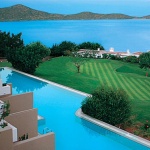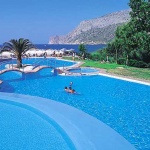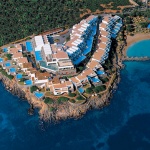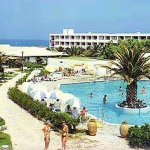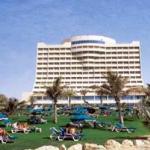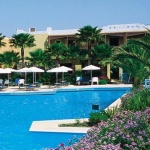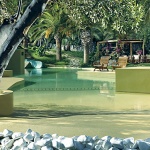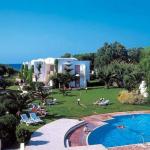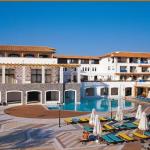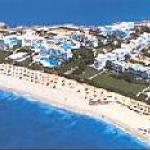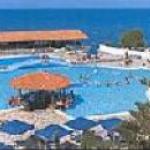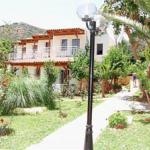Sights Crete, Greece
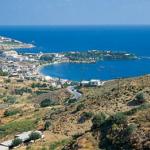 The land chosen by Zeus as their homeland, will enchant guests rich historical heritage and authenticity of folk culture, unusual legends of Minos, the Minotaur and the maze at Knossos.
The land chosen by Zeus as their homeland, will enchant guests rich historical heritage and authenticity of folk culture, unusual legends of Minos, the Minotaur and the maze at Knossos.Them survive the many realities that distant time, as reflected in the legends and myths. Until now, local residents are proud to show the cave, where Zeus was born. Ruins of the maze at Knossos, in which he lived monstrous Minotaur, reminiscent of a great power of the Cretan king Minos. Excavations of the ancient Minoan palace at Knossos; Festa; Zakros for many years attracted the attention of both archaeologists, and tens of thousands of tourists.
Excursion to Knossos Palace - one of the most popular among tourists. You will visit the excavations of the palace of Knossos, the center of the Minoan civilization, which is located just 5 kilometers from the city of Heraklion, the capital of Crete. Excavation of the palace were carried out by archaeologist Arthur Evans. In some places reached a five-story palace height, had many hits and corridors.
Its complex architecture is like a maze, and strikes the imagination of visitors. You will see a place which gave rise to the wonderful myths about the Minotaur, beauty Aryandes, about the brave Theseus and the son of Zeus, the wise king Minos. The size and diversity of the surviving buildings, murals and molding throughout the palace, as well as exhibits of the archaeological museum, which you can visit in Heraklion, give a general idea about life and the life of the people of the Minoan era.
Domestic utensils, tools, weapons, ceramics, printing and decorations, all of this - true masterpieces of ancient masters. You will see the richest collection in the Archaeological Museum of Heraklion, which is in its importance is second only to the museum of Athens. Visitors will also have enough free time for sightseeing of the modern city of Heraklion, recreation and shopping.
The rich history of the island of Crete, on whose land were Arabs, Venetians, Turks, left on Crete monuments of different epochs. Byzantine monasteries, Venetian castles and mansions, Turkish mosques adds a unique touch Cretan landscape with its magical blue-green sea, bright sun, golden beaches, tropical palms, majestic mountains and deep gorges.
Arcadia - the most famous of monasteries in Crete. Built in the 13 century, it quickly became one of the richest in Crete. In the uprising in 1866, hundreds of patriots, women and children who were besieging the Turks, were killed after one of them blew up the gunpowder store. Monastery of Arcadia became a symbol of courage and self-sacrifice for the whole world.
Margarites - a major center of production of ceramics for the western Crete. In the village Zonyana visit to one of the most beautiful caves in Crete - Sendoni. The cave is impressive in its interior, it is full of stalactites and stalagmites, and in recent years has been visited.
Anogia - a large village on the western slope of Mount Ida. Living Anogia are predominantly pastoralists, and because until recently they lived separately from the rest of the island, have preserved their way of life, a lot of ancient words, customs, and generally very different from the other Cretans.
Legends and reality, history and modernity are closely intertwined in the lives of today's Crete. Residents of the island of Crete sacred honors its traditions, coming from ancient times. In the villages, and still produce hand-woven carpets, leather goods, ceramics. Widely known Cretan hospitality has always been an integral feature of the nature of these people, largely preserved the patriarchal way of life. Try the national dish of the Cretan cuisine, taste the famous Cretan wine, pour in the dance provocatively dance in one of the Cretan tavernas, and you will feel the soul of this nation; unconquered; proud and dignified, sincere and always welcome at his guests.
Of great interest is the Archaeological Museum of Heraklion, a rich collection of artifacts from Knossos, Phaistos, Malia.
Once Heraklion was the main port of the Venetians in the eastern Mediterranean. Powerful 16 th century defensive walls built around the city, kept up of today. Venetian fortress, Morosini Fountain, the church of St. Mark, Loggia - the main attractions of the old Heraklion.
Today the city is a major sea port, commercial and tourist center. Resorts of Heraklion and the north-east of Crete offers all the conditions for a lovely holiday.
20 km from the city near the resort villages of Malia and Stalida on the sandy shore are modern hotels and water park. At 34 km east of Heraklion is located tourist center of Malia. 3 km from the city you can visit the ruins of the Minoan palace, where it was found a piece of jewelry with the image of the bee, which is the mascot of Crete and is still made by jewelers of the island.
On the west coast of the Bay of Malia, 26 km from Heraklion and is one of the most popular resorts in northern Crete, Hersonissos, which is famous for its magnificent beaches and plenty of shops, bars, restaurants and discos that attract thousands of tourists here, especially young people.
The beauty of Chania, a city with long history, the former capital of Crete, located in the western part of the island. Their cultural and economic revival in the city reached with the arrival of the Venetians.
Constructed of port Firkas, cozy haven, a fortress and ramparts, palaces and luxury mansions, graceful fountains, Venetian neighborhoods with narrow streets have survived to date and do not cease to delight tourists with their beauty.
Chania - is a pleasant and lively city with flowering gardens, beautiful streets, the smell of orange groves in the vicinity of the city, living in the rhythm of modern life.
Among the resorts in southern Crete, located on the shores of the Libyan Sea, a large popular Paleochora, who became famous holiday destination thanks to the luxurious Pahya Ammos beach and the warm Libyan sea, of the surrounding Paleochora and allows to swim here all year round. From here you can go to Chora Sfakion and the islet of Gavdos, the southernmost point of Europe, where, according to legend, the nymph Calypso sheltered wandering Odysseus. This pristine island with clean beaches and pine forests has year-round communication with borough Chora Sfakion. Light-brown hair and blue-eyed locals consider themselves indigenous Cretans, the descendants of Zeus. 12 km from here stands the fortress Frankokastello, well-preserved 14-in. Folk legend says that in late May during the hours of daylight you can see the shadow of armed horsemen, marching at the fort.
Characteristic feature of Haniyskogo landscape - many caves, grottos and gorges. One of the longest and most beautiful Samaria Gorge is located 43 km from Chania. 18 km long, it is considered the largest in Europe. From north to south valley bisecting Lefka-Ori (White Mountains) and ends on the southern coast of Crete near the village of Agia Rumeli. In some places, its width is only 3 m, and the sheer walls reach a height of 600 m. The gorge is a National Wildlife Refuge and the passage through it, resolved from early May to late September. From Chania to the village Kolymbari 20 km stretch beautiful sandy beaches, next to whom, and are almost all the largest hotels in famous resorts of Maleme, Agia Marina, KatoDaratso, Platanias, Gerani, etc.
Agios Nikolaos, the center of the eastern region of the island, is located on the shores of the Gulf of Mirabello. In the past, a small fishing village, now a world-class resort of Agios Nikolaos enjoys great popularity in whole by tourists. More than 400,000 holidaymakers annually take the hotel Agios Nikolaos and its environs. The beautiful harbor city with colorful fishing barges and pleasure craft channel connects with the picturesque lake, which locals call the "bottomless". Here, according to legend, bathed Athena and Artemis.
From Agios Nikolaos can take a walk on a boat on a small island Spinalosha, visit Elounda and Vai. Elounda - one of the most luxurious and fashionable holiday destinations in Crete. First-class hotels, high level of service, excellent climate and the beauty of local landscapes provided Elounda glory of the prestigious resort. At the most eastern tip of Crete are Wai. "Cretan Hawaii - so call this a unique natural spot. Located in a valley between the hills of Europe's only palm forest, golden sand and beautiful sea like a transfer you to the tropics.
Rethymno is located halfway between Heraklion and Haney. The first mention of the town belongs to the time of the Minoan culture. The architecture of Rethymno reflected the features of different eras. Old Harbor, the majestic fortress Fortress, Fountain Rimondi, mosques with minarets, narrow streets and well-preserved Venetian buildings - this is Old Town. His lively shopping streets, tavernas and restaurants in the national Cretan style, contemporary bars, clubs and discos are always full of people. Beautifully rugged coastline, sandy beaches of Rethymnon and the surrounding area, overgrown with date palms, immersed in the green resort village, located N and the coast, offering great opportunities for outdoor activities.
20 km west of Rethymno is a cozy town of Georgioupolis. Here you can sunbathe and swim in the cleanest of the Cretan Sea, Cretan cuisine to taste the local tavern, have fun at the disco or a night bar.
Those interested can visit the local stalactite cave and go to the lake Kournas - the only fresh water lake on the island, located 6 km from Georgioupolis. Of particular interest are the Monastery of Arkadi, whose history is connected with the period of national liberation struggle of the Cretan people, and the monastery Preveli with a small museum and a beautiful view of the Libyan Sea.
